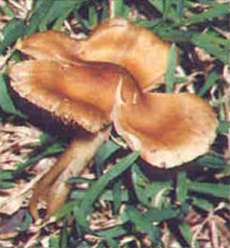Top Qs
Timeline
Chat
Perspective
Aeruginascin
Chemical compound From Wikipedia, the free encyclopedia
Remove ads
Aeruginascin, also known as 4-phosphoryloxy-N,N,N-trimethyltryptamine (4-PO-TMT), is an indoleamine derivative which occurs naturally within the mushrooms Inocybe aeruginascens,[1][2][3][4][5][6] Pholiotina cyanopus,[6] and Psilocybe cubensis.[7] It was discovered by Jochen Gartz.[8][9][10][11][12]
Remove ads
Pharmacology
Summarize
Perspective
Aeruginascin is the N-trimethyl analogue of psilocybin. It is closely related to the frog skin toxin bufotenidine (5-HTQ), a potent serotonin 5-HT3 receptor agonist, but the aeruginascin metabolite 4-HO-TMT (thought to be its active form) shows strong binding at the serotonin 5-HT2 receptors similar to psilocin.[13][14] Aeruginascin itself has been found to have high affinity for the serotonin 5-HT1A, 5-HT2A, and 5-HT2B receptors, but does not bind to the 5-HT3 receptor.[15] Unlike psilocybin, but similarly to 4-HO-TMT, aeruginascin does not produce the head-twitch response in rodents.[16][17] It lacks affinity or activation of the mouse 5-HT2A and 5-HT1A receptors.[17]
The first scientific literature about the pharmacological effects of aeruginascin is from a study published by Gartz in 1989.[18] Across 23 analyzed cases of accidental hallucinogenic mushroom poisonings, people who had ingested the mushroom Inocybe aeruginascens reported only euphoric experiences.[19][20] This is in contrast to the slight and in some cases extremely dysphoric experiences reported from the accidental ingestion of non-aeruginascin-containing mushrooms (containing solely psilocybin and psilocin).[20] However, these findings are anecdotal and preliminary.[20]
Remove ads
See also
References
Wikiwand - on
Seamless Wikipedia browsing. On steroids.
Remove ads


